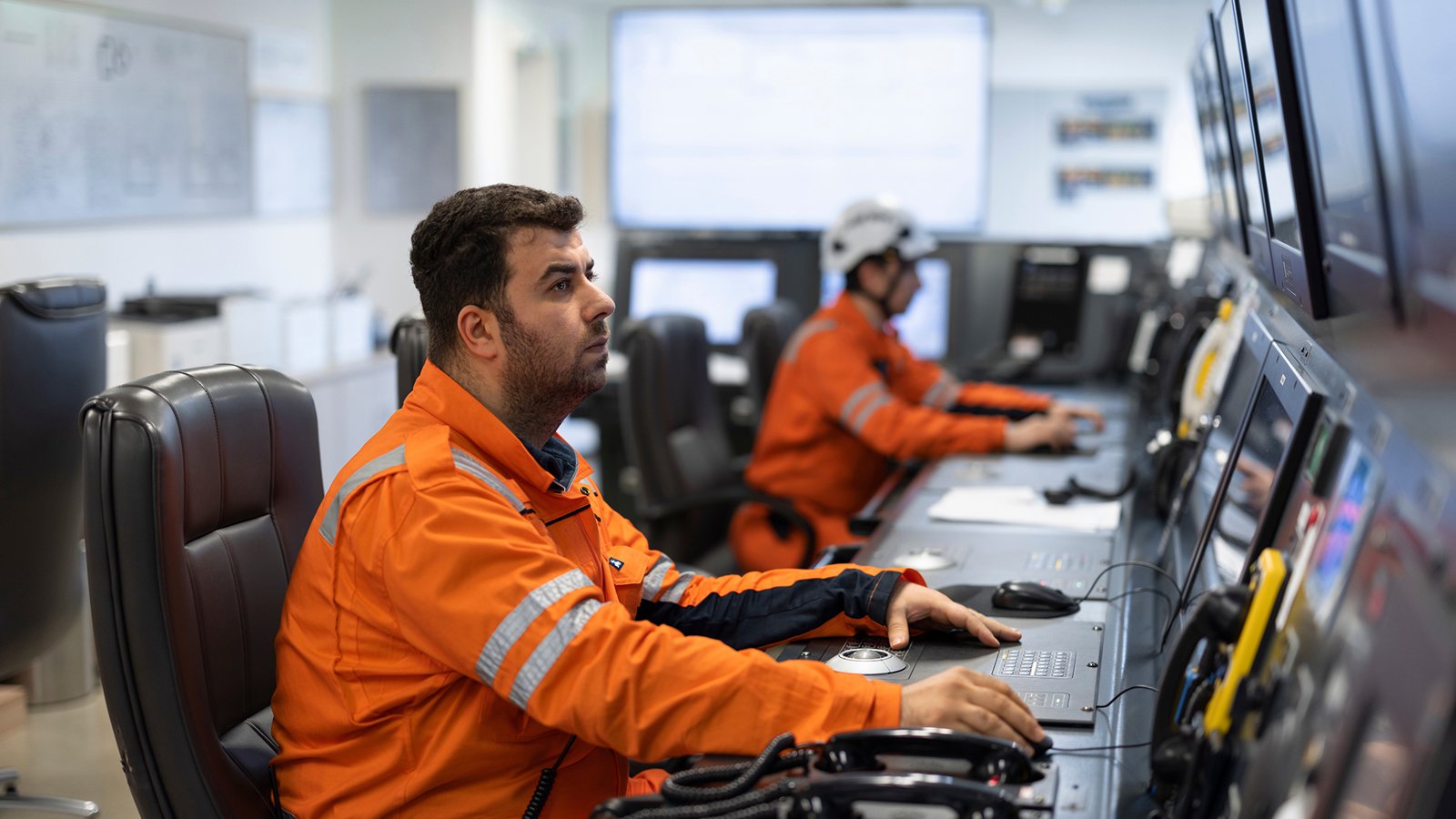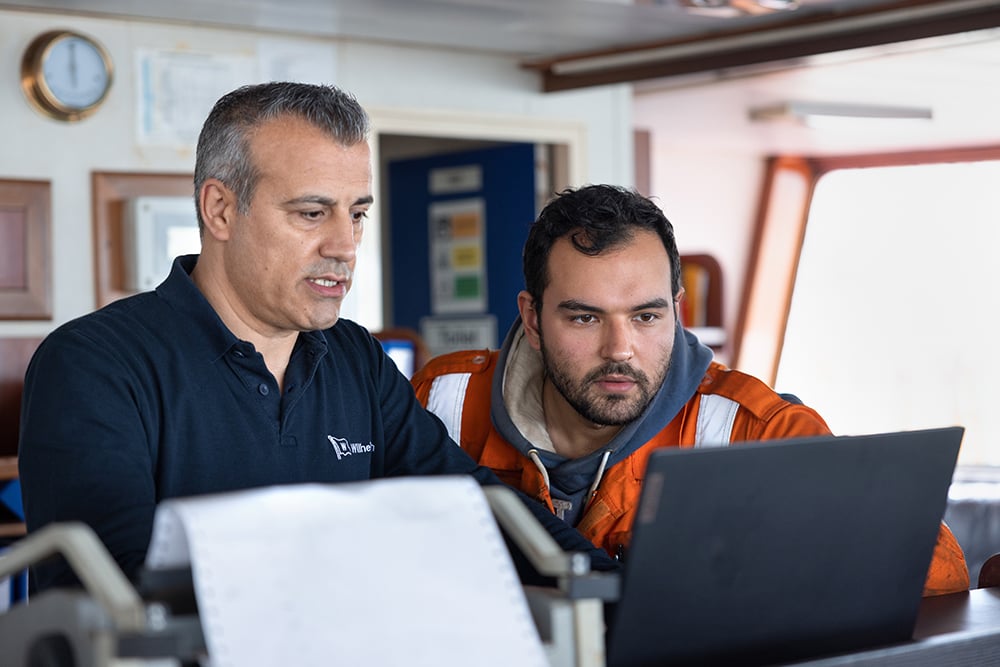Implementing Vessel Performance Monitoring

Wilhelmsen insights
|
Wilhelmsen Ship Management
Vessel performance monitoring is a systematic approach to managing various aspects of a vessel to ensure optimal output and productivity. This process includes monitoring the engine's RPM, fuel consumption per nautical mile, speed, and emissions levels. Using digital tools and information technologies in vessel performance monitoring allows for real-time identification of the ship's onboard status, providing valuable support for continuous improvement and proactive management decision-making.
Choosing the right Vessel Performance Monitoring System
Selecting the appropriate vessel performance monitoring system is crucial for optimizing fleet efficiency and ensuring smooth operations. Here are some important factors to consider when making your decision:
- Compatibility with the Vessel's Systems: Ensure the monitoring system integrates seamlessly with your vessel's existing systems and equipment. This includes compatibility with onboard sensors, engine management systems, and other critical components. Proper integration helps avoid installation issues and ensures smooth data flow, crucial for accurate performance monitoring. Compatibility minimizes disruptions and helps maintain operational continuity.
- Scalability for Fleet-Wide Implementation: Choose a system that can adapt to the size and diversity of your fleet. A scalable solution enables easy expansion and integration across multiple vessels, providing a unified platform for monitoring and managing performance data. This is especially crucial for large fleets or companies with expansion plans. A scalable system guarantees efficient performance data management as your fleet grows or evolves.
- Data Accuracy and Reliability: The accuracy and reliability of the data collected by the monitoring system are extremely important. When looking for a monitoring system, ensure it is equipped with high-precision sensors and robust data validation mechanisms. Reliable data is crucial for obtaining useful insights and making informed decisions to improve operational efficiency. Systems that guarantee data accuracy can help identify performance issues early and optimize vessel operations.
Implementing the Vessel Performance Monitoring System
Implementing a vessel performance monitoring system involves several critical steps to ensure its effectiveness and reliability. Here's a detailed look at the process:
- Pre-installation Assessment: To ensure a successful installation, it's important to assess the vessel's current systems and operational needs thoroughly. This involves evaluating the existing equipment, identifying integration points, and determining the specific performance metrics that need to be monitored. This step ensures that the chosen system will be compatible and meet the vessel's requirements. Understanding the vessel's unique operational profile is crucial for selecting the appropriate monitoring components and configurations.
- Installation of Monitoring Equipment: After completing the assessment, proceed with the installation of the monitoring equipment. This includes setting up sensors, data loggers, and communication devices at strategic points on the vessel. Proper installation is essential for accurate data collection and seamless integration with the vessel's existing systems. Make sure that all equipment is securely mounted and positioned to capture relevant data accurately.
- Calibration and Testing: After installation, calibrate the monitoring equipment to ensure it provides accurate readings. This involves adjusting the sensors and devices to match the vessel's operational parameters. Conduct thorough testing to verify that the system functions correctly and the collected data is reliable. Promptly address any discrepancies to avoid inaccurate performance monitoring. Regular calibration checks are recommended to maintain data integrity over time.
- Training for Crew Members: The crew members must receive thorough training on how to use the monitoring system. This training should include operating the equipment, interpreting the data, and responding to alerts or anomalies. It's crucial to ensure that the crew is proficient in using the system to maximize its benefits and maintain optimal vessel performance. Ongoing training and support can help keep the crew members informed about system upgrades or changes.

Benefits of Vessel Performance Monitoring
Vessel performance monitoring provides numerous benefits that significantly improve the operational efficiency, cost-effectiveness, and environmental sustainability of maritime operations.
Operational Efficiency
Monitoring a vessel's performance provides real-time insights into various operational parameters such as fuel consumption, engine performance, and speed. By continuously tracking these metrics, ship operators can identify inefficiencies and take corrective actions promptly. This proactive approach helps maintain optimal performance levels, reduces downtime, and ensures smoother operations. Additionally, the data collected can fine-tune operational strategies, leading to more efficient voyage planning and execution. Real-time data enables better decision-making and resource allocation, ultimately enhancing overall vessel performance.
For ship owners and operators, vessel performance monitoring is crucial for several reasons:
- It helps reduce operational costs by identifying inefficiencies and optimizing fuel and energy consumption, thereby lowering fuel expenses.
- It ensures compliance with international standards, such as the Energy Efficiency Operational Indicator (EEOI) and the Carbon Intensity Indicator (CII), essential for sustainable shipping practices and comparative performance indicators data.
- By maintaining optimal vessel performance monitoring, ship owners can enhance the longevity and reliability of their fleet, leading to fewer breakdowns and maintenance issues.
Cost Efficiency
One of the most significant benefits of vessel performance monitoring is the potential for substantial cost savings. Ship owners can significantly reduce fuel expenses by optimizing fuel consumption and improving operational efficiency - a major component of operational costs. Furthermore, early detection of performance issues enables timely maintenance and repairs, preventing costly breakdowns and extending the lifespan of the vessel's equipment. These cost savings contribute to a more profitable, sustainable maritime business. Improved efficiency also translates to better asset utilization, maximizing return on investment for fleet operators.
Environmental and Regulatory Compliance
Advanced monitoring systems are essential for enhancing fuel efficiency and overall operational performance. By meticulously tracking fuel consumption and emission levels, these systems enable shipping companies to identify inefficiencies and optimize operations. This emphasis on energy efficiency not only reduces fuel costs but also contributes to lower emissions, decreasing the number of EU Allowances (EUAs) required and minimizing exposure to fluctuating carbon prices.
The European Union Emissions Trading System (EU ETS) now includes the maritime sector, introducing new regulatory requirements for ship operators:
- Monitoring and Reporting Emissions: Ship operators must accurately track and report their carbon emissions to comply with EU regulations. Effective emission management can reduce EUA requirements, thereby lowering costs and maintaining the organization’s financial health.
- Securing EU Allowances (EUAs): Operators need to acquire sufficient EUAs to cover their emissions. As the cap on allowances tightens, effective emission management becomes essential to avoid rising costs. Managing emissions effectively can help mitigate the impact of increasing EUA prices.
Emission control methods are crucial for maritime companies to manage the financial burden of carbon emissions. Implementing efficient emission management strategies ensures compliance with EU ETS while controlling the costs associated with EU Allowances.
FAQs regarding Vessel Performance Monitoring
How do you check vessel performance?
Vessel performance can be evaluated using different methods. Manual observation involves crew members recording performance metrics such as optimize fuel consumption, speed, and engine parameters. Onboard sensors continuously monitor and transmit data on key performance indicators, providing more accurate and real-time insights. Advanced performance monitoring systems take this further by integrating data from multiple sources, offering real-time analytics and comprehensive performance assessments.
Why is a vessel monitoring system important?
A vessel monitoring system is essential for several reasons. It improves operational efficiency by identifying inefficiencies and optimizing operations in real-time. Safety is another significant benefit, as continuous monitoring helps detect potential issues early, reducing the risk of accidents. Cost savings are also substantial, as optimized fuel consumption and maintenance schedules can lead to significant financial benefits. Additionally, these systems ensure regulatory compliance by helping vessels adhere to international regulations and standards.
What are the different types of vessel monitoring systems?
There are various types of ship performance monitoring systems available. Basic onboard systems offer fundamental monitoring capabilities, such as tracking vessel's fuel consumption and engine performance. Advanced performance monitoring software provides detailed analytics and real-time data visualization, enabling more precise performance management. Integrated vessel management systems combine performance monitoring with other operational aspects, such as navigation and maintenance management, offering a comprehensive solution for vessel operations.
What is the importance of a vessel monitoring system on a ship?
A vessel monitoring system enhances operational efficiency, safety, and overall performance. These systems optimize vessel operations by providing real-time data, ensuring smoother and more efficient journeys. Continuous monitoring helps detect anomalies early, allowing for prompt corrective actions and enhancing safety. Additionally, these systems contribute to better decision-making, reduced downtime, and extended equipment lifespan, ultimately improving the vessel’s overall performance.
Explore how our vessel performance monitoring solutions can help you enhance efficiency, reduce costs, and stay compliant. Contact us today to learn more or to schedule a consultation with our experts.